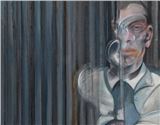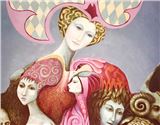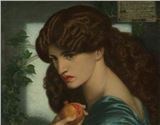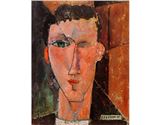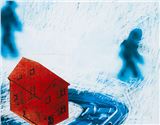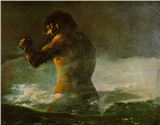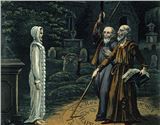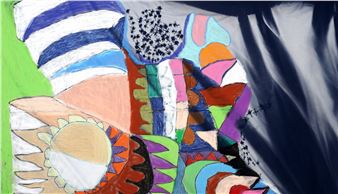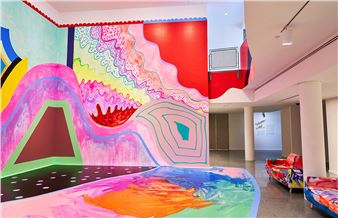Indeterminate Stillness: Looking at WhistlerÔÇé
Indeterminate Stillness looks at Whistler through the panoramic range of his prints, which he made throughout his career, creating nearly five hundred etchings in addition to lithographs, linotints, and engravings. This exhibition also celebrates an extraordinary gift by Sharon and Barclay Simpson, avid collectors of WhistlerÔÇÖs graphic work and longtime patrons and supporters of the University of California and particularly of the Berkeley Art Museum and Pacific Film Archive. The SimpsonsÔÇÖ generous gift of seventy-six prints by Whistler spans the thirty-year arc of his career and includes works from WhistlerÔÇÖs most important print series, such as The Thames Set and both major series of Venetian prints.
Whistler was born in Massachusetts, but spent his early years in St. Petersburg, Russia, where his father was a successful engineer and where James first studied art. After his family returned to America, Whistler briefly attended West Point Academy, then landed a job with the U.S. Coast and Geodetic Survey, where he was trained as an etcher. However, he was intent on a bohemian artistic life and soon moved to Paris and then to London, where he would be based for the rest of his life.
In Paris, Whistler attended the popular studio of Charles Gabriel Gleyre, a follower of Ingres. The galleries of the Louvre, however, provided more influential models for Whistler, particularly the approach to light, tonal variation, and spatial composition in the works of seventeenth-century Dutch and Spanish masters Rembrandt, Vermeer, and Velazquez. Whistler and his circle of young artist and writer friendsÔÇöHenri Fantin-Latour, Gustave Courbet, Edward Degas, Claude Monet, Charles Baudelaire, St├®phane Mallarm├® ÔÇöwere drawn to Realism but not necessarily to tradition.
In 1858 Whistler published his first portfolio of etchings, Twelve Etchings from Nature, also known as The French Set. Based on the success of this portfolio, Whistler moved to London where he continued his depictions of contemporary life. In 1871 he published a new portfolio of etchings, The Thames Set. Like Rotherhithe, which was part of the The Thames Set, the other scenes in the series are also intricately composed, with strong echoes of Realism. In these etchings, Whistler draws on design principles found in the Japanese prints of the Edo period that he and his circle collected with a passion.
In 1886 and 1889, the Fine Arts Society in London published two sets of etchings that Whistler had made during extended stays in Italy, particularly Venice. They include both figures and city views, demonstrating WhistlerÔÇÖs skilled draftsmanship and his extraordinary sense of atmosphere. Nocturne (1879-80) is from the first of the Venice sets. With a minimum of incised lines, the simple scene is enveloped in a rich darkness of water and sky, warm tones of black effectively evoking the humid atmosphere of Venice after dusk. Like many of his works of the 1860s and 1870s, paintings as well as works on paper, figures as well as seascapes, NocturneÔÇÖs essence resides in a simple arrangement of closely related, harmonious color tonalities, an essence that stills and liberates the specifics of incident.
Later this spring, internationally acclaimed Bay Area artist Robert Bechtle will speak in conversation with Barclay Simpson about Whistler, whose influence Bechtle has long acknowledged. His subjects are the qualities of light and atmosphere particular to the Bay Area as much as they are his immediate surroundings in middle-class San Francisco neighborhoodsÔÇöparked cars, garages, ordinary people in back yards. In writing about BechtleÔÇÖs recent watercolors and drawings, critic Robert Storr noted an imposed stillness and inherent poetry that recalls the tonal harmonies of James McNeil Whistler. In an observation that could apply equally well to WhistlerÔÇÖs prints, Storr suggests that underlying the stillness of BechtleÔÇÖs compositions whirs a velocity of spirit. (Robert Bechtle: Watercolors and Drawings, San Francisco: Gallery Paule Anglim, 2010).
Lucinda Barnes
Chief Curator and Director of Programs and Collections

Recommended for you
Indeterminate Stillness looks at Whistler through the panoramic range of his prints, which he made throughout his career, creating nearly five hundred etchings in addition to lithographs, linotints, and engravings. This exhibition also celebrates an extraordinary gift by Sharon and Barclay Simpson, avid collectors of WhistlerÔÇÖs graphic work and longtime patrons and supporters of the University of California and particularly of the Berkeley Art Museum and Pacific Film Archive. The SimpsonsÔÇÖ generous gift of seventy-six prints by Whistler spans the thirty-year arc of his career and includes works from WhistlerÔÇÖs most important print series, such as The Thames Set and both major series of Venetian prints.
Whistler was born in Massachusetts, but spent his early years in St. Petersburg, Russia, where his father was a successful engineer and where James first studied art. After his family returned to America, Whistler briefly attended West Point Academy, then landed a job with the U.S. Coast and Geodetic Survey, where he was trained as an etcher. However, he was intent on a bohemian artistic life and soon moved to Paris and then to London, where he would be based for the rest of his life.
In Paris, Whistler attended the popular studio of Charles Gabriel Gleyre, a follower of Ingres. The galleries of the Louvre, however, provided more influential models for Whistler, particularly the approach to light, tonal variation, and spatial composition in the works of seventeenth-century Dutch and Spanish masters Rembrandt, Vermeer, and Velazquez. Whistler and his circle of young artist and writer friendsÔÇöHenri Fantin-Latour, Gustave Courbet, Edward Degas, Claude Monet, Charles Baudelaire, St├®phane Mallarm├® ÔÇöwere drawn to Realism but not necessarily to tradition.
In 1858 Whistler published his first portfolio of etchings, Twelve Etchings from Nature, also known as The French Set. Based on the success of this portfolio, Whistler moved to London where he continued his depictions of contemporary life. In 1871 he published a new portfolio of etchings, The Thames Set. Like Rotherhithe, which was part of the The Thames Set, the other scenes in the series are also intricately composed, with strong echoes of Realism. In these etchings, Whistler draws on design principles found in the Japanese prints of the Edo period that he and his circle collected with a passion.
In 1886 and 1889, the Fine Arts Society in London published two sets of etchings that Whistler had made during extended stays in Italy, particularly Venice. They include both figures and city views, demonstrating WhistlerÔÇÖs skilled draftsmanship and his extraordinary sense of atmosphere. Nocturne (1879-80) is from the first of the Venice sets. With a minimum of incised lines, the simple scene is enveloped in a rich darkness of water and sky, warm tones of black effectively evoking the humid atmosphere of Venice after dusk. Like many of his works of the 1860s and 1870s, paintings as well as works on paper, figures as well as seascapes, NocturneÔÇÖs essence resides in a simple arrangement of closely related, harmonious color tonalities, an essence that stills and liberates the specifics of incident.
Later this spring, internationally acclaimed Bay Area artist Robert Bechtle will speak in conversation with Barclay Simpson about Whistler, whose influence Bechtle has long acknowledged. His subjects are the qualities of light and atmosphere particular to the Bay Area as much as they are his immediate surroundings in middle-class San Francisco neighborhoodsÔÇöparked cars, garages, ordinary people in back yards. In writing about BechtleÔÇÖs recent watercolors and drawings, critic Robert Storr noted an imposed stillness and inherent poetry that recalls the tonal harmonies of James McNeil Whistler. In an observation that could apply equally well to WhistlerÔÇÖs prints, Storr suggests that underlying the stillness of BechtleÔÇÖs compositions whirs a velocity of spirit. (Robert Bechtle: Watercolors and Drawings, San Francisco: Gallery Paule Anglim, 2010).
Lucinda Barnes
Chief Curator and Director of Programs and Collections

 ARTISTS
ARTISTS
